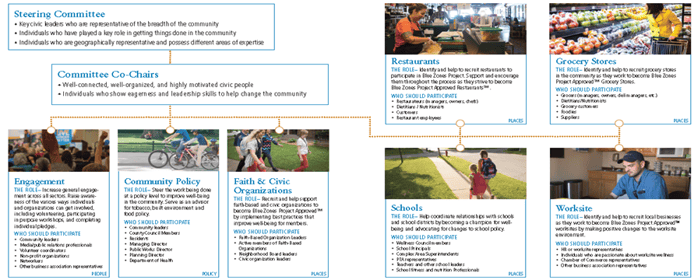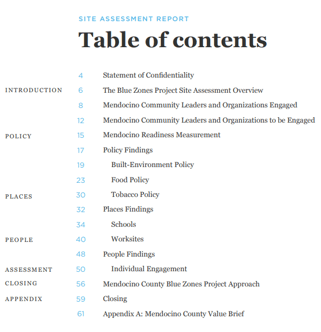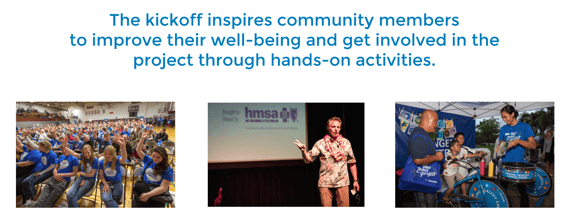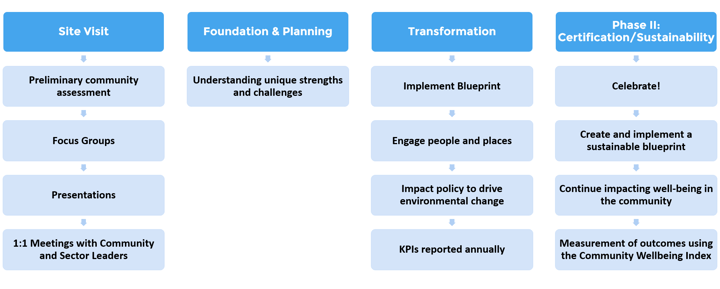![]()
THE STAGES OF COMMUNITY TRANSFORMATION
The 2-Day Site Visit
Before we select a Blue Zones Project community, we often host a 2-Day Site Visit to assess if the community is ready for Blue Zones Project. During the visit, the Blue Zones Project team conducts a series of focus groups and 1:1 meetings with key stakeholders and community organizations. The community also presents to the team to show why they want Blue Zones Project to come to their community and examples of past initiatives that show the community can successfully rally around an issue.
After conducting a Site Visit, we complete a Site Visit Report which includes the readiness factors we just mentioned as well as outlines the strengths, challenges, and opportunities in each of the areas Blue Zones Project works—people, places, and policy.
Discussing these findings is important because this information will help to guide your strategy during the Foundation and Planning Phase. For example, if you have noticeable gaps from the worksite community, you’ll need to think about how as a team you will engage this community during this phase.
ACTIVITY | Connect to your Community
Spend a bit of time looking at the Site Visit Report from your community.
Consider the following questions:
- Did anything surprise you from the Site Visit Report?
- What do you think were the biggest strengths and challenges?
- What gaps did you learn about and how would you fill them during the Foundation and Planning Phase?
KEY MILESTONES
Once a community is selected, the first 6 to 8 months are spent trying to understand the strengths and challenges of implementing Blue Zones Project in the community. Let's review the key milestones and activities of the foundation and planning phase.
DENOMINATORS
One of the first steps in seeking certification as a Blue Zones Community® is to establish the potential audience, or denominator, for engagement in each of the Blue Zones Project pillar areas.
Each pillar area includes management objectives, which will inform training, strategy, and implementation and should be addressed in your community Blueprint or Implementation Plan as appropriate.
RecruitING & trainING: Local Team
As a best practice, Blue Zones Project always tries to hire individuals who are both from and well-connected within the community.
It is important that staff come in with an understanding of the community and deeply established relationships throughout the community that can be leveraged to drive engagement with Blue Zones Project.
Standard roles usually include:
Executive Director/Community Program Manager: Manages the team and typically drives the policy and schools work.
Engagement Lead: Coordinates all of the individual engagement activities like purpose workshops, moai formation, volunteer opportunities, and marketing and social media campaigns to create awareness and drive engagement in the Project.
Policy Lead: Leads the policy work in Built Environment, Food, and Tobacco.
Organization Lead: Works with businesses including, worksites, faith-based organizations, restaurants, etc. to become engaged in the project.
Event and Office Coordinator: Helps with administrative tasks and event execution.
![]()
RecruitING & trainING: Committee Members
The project’s success is dependent upon the commitment of community members to provide strategic guidance, break down barriers, and take ownership of transformation in the sectors we work in.
Below is the structure of our committees in the community:

The Steering Committee and Leadership Team are comprised of community leaders who are well recognized in the community, and represent the many sectors we do work in, as well as the diverse population in your community. These are the movers and shakers who have deep relationships in the community and know how to get things done. They meet more frequently at the beginning of the project as they guide what will be in the Blueprint, community implementation plan, and meet throughout the life of the project to provide strategic guidance.
The Implementation Committees are made of individuals who will execute the Blueprint. People on these committees are the doers.
Policy Discovery & Summits
During policy discovery, Blue Zones Project policy experts meet with local experts and community leaders to learn about the strengths, challenges, and opportunities in the built, food, and smoke-free environments.
Then, during policy summits, local stakeholders collectively identify which best practice policies to pursue to improve these environments. Objectives are to engage all stakeholders in each of those areas that are needed to collectively prioritize policies for the community, including key decision-makers.
Sector Discovery: Focus Groups & 1:1 Meetings
The purpose of Discovery is to get people thinking about how the environments within their life radius could be designed to better support health and well-being. Through focus groups, 1:1 meetings, and research, we identify opportunity areas and local partners willing to work together to create change.

The focus groups and 1:1 meetings engage community leaders to introduce them to Blue Zones Project and get their support. We need broad-reaching participation across all of the people, places, and policy sectors we work in. Many leaders, we meet with 1:1 so they have the opportunity to ask questions in a more private setting.
We hold focus groups for each of the areas where we do work (worksites, schools, restaurants, grocery stores, faith-based/civic, media, policy), inviting hundreds of stakeholders from these sectors and community members at large to provide their unique perspective about the strengths, challenges, and opportunities for improving well-being in their sector and community. Typically these meetings occur over course of a week or two with several time slots to accommodate busy schedules.
The information learned from the Focus Groups and 1:1 meetings is put into the Discovery Report.
Discovery report
The Discovery Report summarizes each sector’s strengths, challenges, and opportunities identified through community member engagement and background research.


*The Discovery Report also feeds into the Blueprint.
Key Steps:
- Local team plans & facilitates Focus Groups & 1:1's
- Local team develops report
- Central COE team reviews
- Local team incorporates edits
- BZ LLC reviews
- Local team incorporates edits
- Copy editing & design
- Distribute to sponsor & committees
![]()
Blueprint
The Blueprint is a strategic plan outlining the measurement strategy and objectives, strategies, and progress and outcome metrics for each of the Blue Zones Project sectors.

*The Blueprint is created by the Steering Committee and Leadership Team and is updated annually.
Key Steps:
- Local team plans & facilitates Blueprint workshop
- Local team drafts Blueprint
- Central COE team reviews
- Local team incorporates edits
- BZ LLC reviews
- Local team incorporates edits
- Copy editing & design
- Distribute to sponsor & committees
Community Kickoff

![]()



